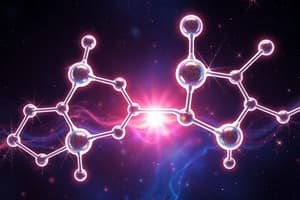Podcast
Questions and Answers
When naming alkenes, what must the longest continuous chain include?
When naming alkenes, what must the longest continuous chain include?
- Both alkene carbons. (correct)
- The carbon with the lowest atomic weight.
- All carbons, regardless of single or double bonds.
- The most substituents.
What is the correct IUPAC name for a five-carbon chain with double bonds between carbons 1 and 2, and carbons 3 and 4, with a methyl group attached to carbon 2?
What is the correct IUPAC name for a five-carbon chain with double bonds between carbons 1 and 2, and carbons 3 and 4, with a methyl group attached to carbon 2?
- 2-methyl-1,3-butadiene (correct)
- 2-methyl-2,4-pentadiene
- 4-methyl-1,3-pentadiene
- 2-methyl-1,3-pentadiene
What distinguishes cis and trans alkenes?
What distinguishes cis and trans alkenes?
- The arrangement of alkyl groups around the carbon atoms.
- The types of carbon atoms in the compound.
- The total number of carbons in the compound.
- The position of hydrogen atoms around the double bond. (correct)
When naming alkynes, what is the most important factor in selecting the main carbon chain?
When naming alkynes, what is the most important factor in selecting the main carbon chain?
What is the correct IUPAC name for a seven-carbon chain with a triple bond between carbons 1 and 2, and a propyl group attached to carbon 3?
What is the correct IUPAC name for a seven-carbon chain with a triple bond between carbons 1 and 2, and a propyl group attached to carbon 3?
How are compounds containing both alkene and alkyne groups named?
How are compounds containing both alkene and alkyne groups named?
When naming alkyl halides, how are the halogen atoms treated?
When naming alkyl halides, how are the halogen atoms treated?
What is the IUPAC name for a benzene ring with a chlorine substituent?
What is the IUPAC name for a benzene ring with a chlorine substituent?
Which of the following is the correct name for a benzene ring with two methyl groups attached to adjacent carbon atoms?
Which of the following is the correct name for a benzene ring with two methyl groups attached to adjacent carbon atoms?
In naming polysubstituted benzenes, how should the substituents be numbered?
In naming polysubstituted benzenes, how should the substituents be numbered?
What is the primary characteristic used to identify primary, secondary, and tertiary alcohols?
What is the primary characteristic used to identify primary, secondary, and tertiary alcohols?
What is the correct IUPAC name for a three-carbon alcohol with the -OH group on the second carbon?
What is the correct IUPAC name for a three-carbon alcohol with the -OH group on the second carbon?
What is a key characteristic of aldehyde groups in organic compounds?
What is a key characteristic of aldehyde groups in organic compounds?
What is the IUPAC name of a four-carbon aldehyde?
What is the IUPAC name of a four-carbon aldehyde?
How do ketones differ from aldehydes in terms of the position of the carbonyl group?
How do ketones differ from aldehydes in terms of the position of the carbonyl group?
In ketones, where is the carbonyl group always located?
In ketones, where is the carbonyl group always located?
What is the correct IUPAC name for a seven-carbon ketone with a carbonyl group on the fourth carbon, and methyl groups on the second and sixth carbons?
What is the correct IUPAC name for a seven-carbon ketone with a carbonyl group on the fourth carbon, and methyl groups on the second and sixth carbons?
What is a defining characteristic of carboxylic acids in terms of the position of the carboxyl group?
What is a defining characteristic of carboxylic acids in terms of the position of the carboxyl group?
What is the IUPAC name for a four-carbon carboxylic acid?
What is the IUPAC name for a four-carbon carboxylic acid?
What is the functional group present in nitriles?
What is the functional group present in nitriles?
What is the IUPAC name for a three-carbon nitrile?
What is the IUPAC name for a three-carbon nitrile?
In the Fischer esterification reaction, what two reactants combine to form an ester?
In the Fischer esterification reaction, what two reactants combine to form an ester?
In naming esters, what does the '-oate' suffix indicate?
In naming esters, what does the '-oate' suffix indicate?
When naming alkenes, if there's a choice between numbering to give the double bond the lowest number versus a substituent, which takes priority?
When naming alkenes, if there's a choice between numbering to give the double bond the lowest number versus a substituent, which takes priority?
Which of the following is true regarding the properties of cis and trans isomers of alkenes?
Which of the following is true regarding the properties of cis and trans isomers of alkenes?
What is the systematic approach for naming complex organic molecules with multiple functional groups?
What is the systematic approach for naming complex organic molecules with multiple functional groups?
Which of the following best describes how halogen substituents are named when attached to a benzene ring?
Which of the following best describes how halogen substituents are named when attached to a benzene ring?
How are alcohols classified based on the carbon atom attached to the hydroxyl (-OH) group?
How are alcohols classified based on the carbon atom attached to the hydroxyl (-OH) group?
In the IUPAC naming system for organic compounds, what is the significance of numbering the carbon atoms?
In the IUPAC naming system for organic compounds, what is the significance of numbering the carbon atoms?
Flashcards
Alkene Naming: Chain Selection
Alkene Naming: Chain Selection
In alkene naming, the longest continuous carbon chain must include both alkene carbons for accurate nomenclature.
Naming Alkenes with Multiple Double Bonds
Naming Alkenes with Multiple Double Bonds
When dealing with multiple alkene groups, name the compound by indicating the position of each double bond.
Cis vs. Trans Alkenes
Cis vs. Trans Alkenes
"Cis" alkenes have hydrogen atoms on the same side of the double bond, while "trans" alkenes have them on opposite sides.
Alkyne Naming: Chain Identification
Alkyne Naming: Chain Identification
Signup and view all the flashcards
Compounds with Alkene and Alkyne Groups
Compounds with Alkene and Alkyne Groups
Signup and view all the flashcards
Naming Alkyl Halides
Naming Alkyl Halides
Signup and view all the flashcards
Naming Monosubstituted Benzenes
Naming Monosubstituted Benzenes
Signup and view all the flashcards
Naming Disubstituted Benzenes
Naming Disubstituted Benzenes
Signup and view all the flashcards
Naming Polysubstituted Benzenes
Naming Polysubstituted Benzenes
Signup and view all the flashcards
Naming Alcohols
Naming Alcohols
Signup and view all the flashcards
Aldehydes: Position of Group
Aldehydes: Position of Group
Signup and view all the flashcards
Ketones: Position of Group
Ketones: Position of Group
Signup and view all the flashcards
Carboxylic acids: Position of Group
Carboxylic acids: Position of Group
Signup and view all the flashcards
Naming Nitriles
Naming Nitriles
Signup and view all the flashcards
Ester Formation
Ester Formation
Signup and view all the flashcards
Naming Esters Components
Naming Esters Components
Signup and view all the flashcards
Study Notes
Naming Alkenes
- The longest continuous chain must include BOTH alkene carbons.
- Even if a longer chain exists, the chain with the alkene carbons is prioritized.
- The longest carbon chain is only 5 carbons long when it contains BOTH alkene carbons.
- To name an alkene, indicate where the double bond is, with the double bond receiving the lowest possible number.
- Example: 2-propyl-1-pentene or 2-propylpent-1-ene.
- When dealing with more than one alkene group, the substance is named accordingly, for example: 2-methyl-1,3-butadiene
Cis and Trans Alkenes
- Cis alkenes have hydrogens on the same sides of the double bond.
- Trans alkenes have hydrogens on opposite sides of the double bond.
- Cis and Trans alkenes have different properties.
Naming Alkynes
- The longest continuous carbon chain should contain both alkyne carbons.
- Example: 3-propyl-1-heptyne
- Combination molecules of alkenes and alkynes are named as an "enyne".
- 5-methyl-1-hepten-6-yne is an example, where the 1st double bond and 2nd triple bond are numbered.
Naming Alkyl Halides
- Halogen atoms, when naming, are treated as regular branches
- For example: 3-chloro-2-methylpentane.
Naming Benzene Compounds
- Monosubstituted benzenes have common names like chlorobenzene, nitrobenzene, and cyanobenzene.
- Trivial names also exist, such as phenol, aniline, benzoic acid, and toluene.
- Systematic (IUPAC) names exist, such as hydroxybenzene, aminobenzene, carboxybenzene, and methylbenzene.
- Disubstituted benzenes include 1,2-dimethylbenzene, 1,3-dimethylbenzene, and 1,4-dimethylbenzene.
- These can also be named ortho-xylene, meta-xylene, and para-xylene, o-xylene, m-xylene, and p-xylene, respectively.
- Polysubstituted benzenes are named with numbers indicating the positions of the substituents.
- Examples include 4-bromo-2-methylnitrobenzene, 5-bromo-2-nitrotoluene, and 3-methyl-4-nitrobromobenzene.
- Further examples include 1,4-dimethyl-2-propylbenzene, 4-methyl-2-propyltoluene, and 2,5-dimethylpropylbenzene.
- Another example is 2-methyl-1,3,5-trinitrobenzene or 2,4,6-trinitrotoluene.
Naming Alcohols
- The longest continuous chain containing the -OH group is used to name alcohols.
- Propan-1-ol is a primary alcohol.
- Propan-2-ol is a secondary alcohol.
- Examples of complex alcohols include 4-methyl-1,2,4-pentanetriol and 4-methylpentane-1,2,4-triol.
Naming Aldehydes
- The aldehyde group is always in a terminal position.
- Examples of aldehydes include methanal, ethanal, and benzaldehyde.
- Also examples include methylpropanal, 2,2-dimethylbutanal, and butanal.
- The -CHO group is always where numbering starts.
Naming Ketones
- The aldehyde group is always in a terminal position.
- The ketone group is always in an internal position.
- An example is 2,6-dimethyl-4-heptanone or 2,6-dimethylheptan-4-one
Naming Carboxylic Acids
- Carboxylic acid group is always in a terminal position.
- Examples include butanoic acid (butyric acid) and propanoic acid (propionic acid).
- Additional examples include 2-Methylpentanoic acid (B-Methylvaleric acid), and 3-Chloropropanoic acid (y-Chloropropionic acid).
Naming Nitriles
- Nitriles contain the cyano group, -C≡N
- Examples for Nitriles:
- Ethyl cyanide or Propiononitrile, IUPAC name: Propane nitrile
- Vinyl cyanide or Acryl nitrile, IUPAC name: Prop-2-ene nitrile
- Isopropyl cyanide or Isobutyl r o nitrile, IUPAC name: 2-Methyl popane nitrile
- Tolyl cyanide p-toluonitrile, IUPAC name: p-toluenenitrile
Naming Esters
- Esters are involved in the Fischer esterification reaction: alcohol + carboxylic acid → ester + H2O
- Some examples include Methyl ethanoate and Ethyl propanoate.
Studying That Suits You
Use AI to generate personalized quizzes and flashcards to suit your learning preferences.




